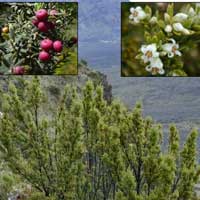|
Identification:
New Zealand tea tree, aka manuka, is a compact shrub or small tree grows to 6 m (20 ft) with many erect thin branches. Tea tree prefers sunlight and drier conditions. Lancelike, narrow (8-15 mm or 1/3-1/2 in wide) leaves are ALTERNATE in growth arrangement. Oil glands beneath the leaves produce an astringent "tea tree oil" smell. Small white to pink flowers grow at the end of small stems growing sideways of of main branches. Tiny 5 valved brown seeds (1.5 mm) are numerous.
Impacts: This prolific seeder can jump the garden fence and invade Hawaiian forests. This shrub is naturalizing in areas of the islands of Kauai, Oahu, and is particularly prevalent at Lanaihale, Lanai.
Dispersal Mechanism: New Zealand Tea Tree is native to New Zealand and Tasmania, but has been introduced throughout Hawaii as a garden plant and forestry planting. It is currently only known to grow in a few locations in Hawaii (see map). If you see it anywhere else- let someone know!
More information about this pest 
|
|
Pukiawe (Styphelia tameiameiae):
Pukiawe is a small, variable shrub that is native to Hawaii. This shrub ranges from coastal to alpine, though it is most prominent in higher elevations. The small lance like leaves often have a dull white hue. Flowers are white to pink, and smaller than the tea trees. Mature fruit is dark red, pink or white.
|

|
|
Pukiawe (Styphelia tameiameiae)
|
|